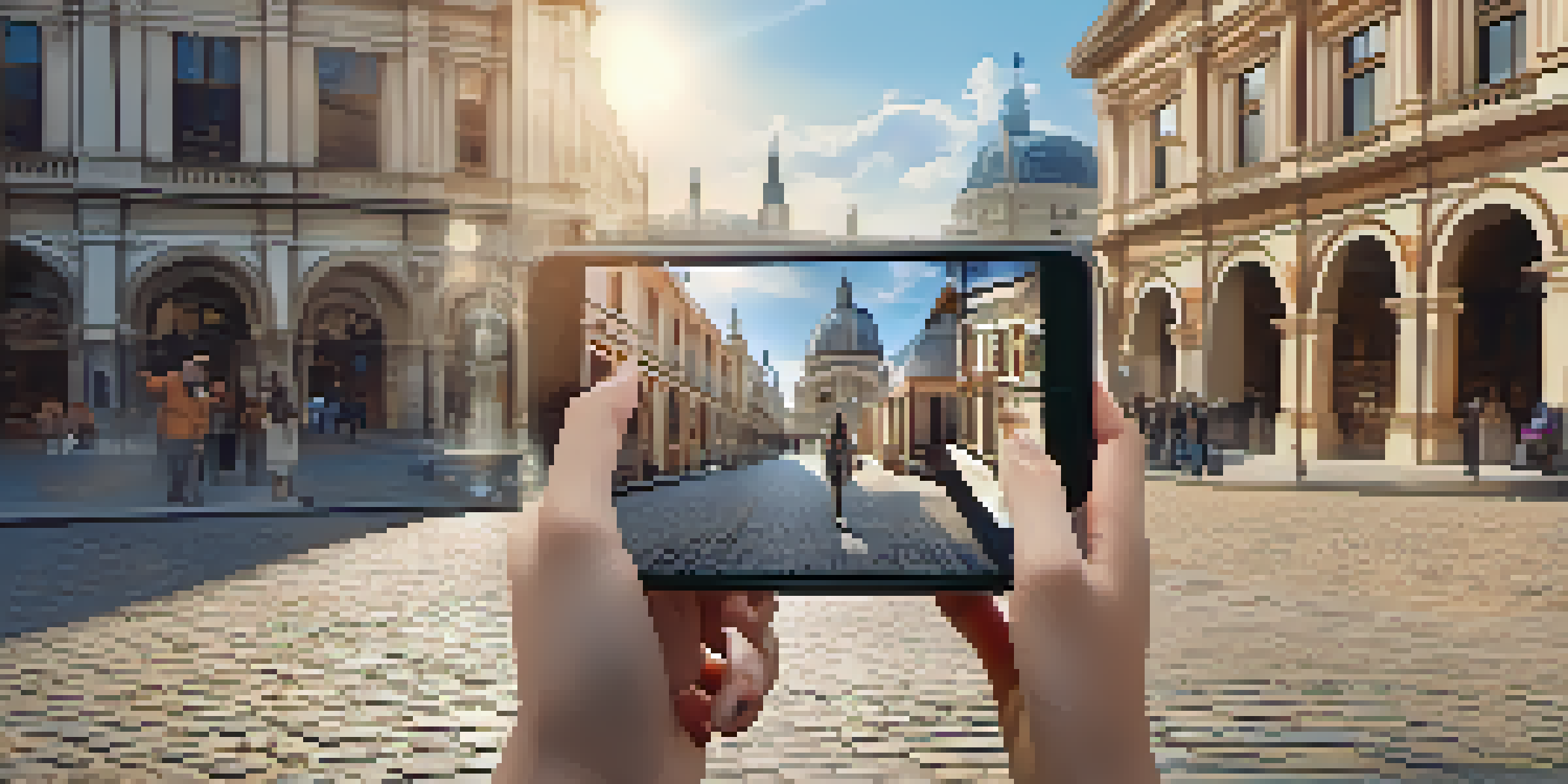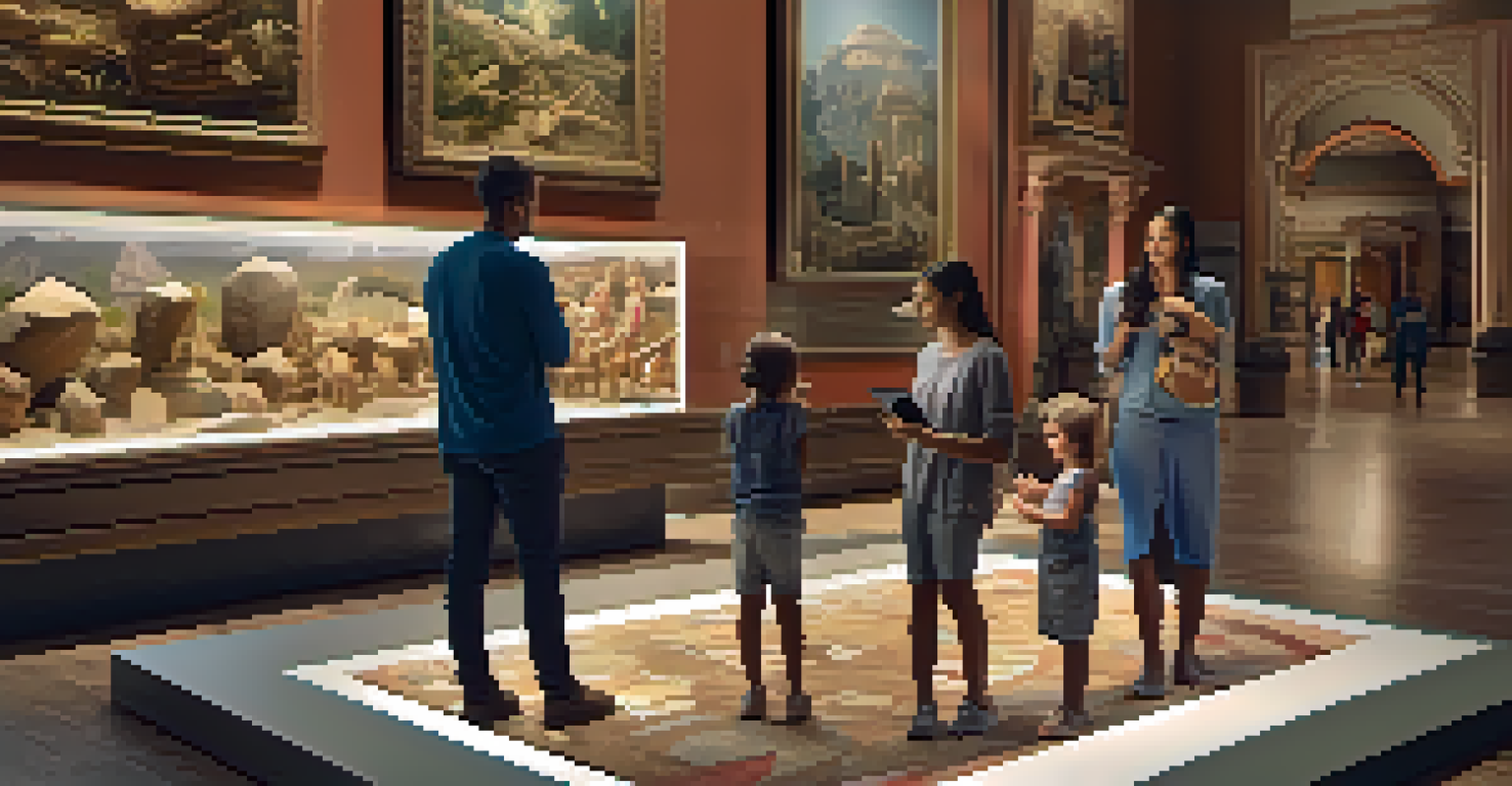Augmented Reality in Tourism: Interactive Travel Guides

Understanding Augmented Reality in Tourism
Augmented reality (AR) blends digital content with the real world, creating interactive experiences. In tourism, this technology allows travelers to engage with their surroundings in new and exciting ways. Imagine walking through a historic city and seeing historical figures come to life right before your eyes, sharing stories and insights about the location.
The future is already here — it's just not very evenly distributed.
This immersive experience makes learning about culture and history not only informative but also fun. AR can enhance traditional travel guides by adding layers of information, turning a simple stroll into an educational journey. For instance, a traveler can point their smartphone at a monument and instantly see its history, architectural details, and even visitor reviews.
As AR technology continues to evolve, it becomes more accessible to both travelers and businesses. This opens up a world of possibilities, from self-guided tours enhanced by AR apps to interactive experiences in museums and historical sites. The integration of AR in tourism is just beginning, and its potential is already proving to be transformative.
The Role of Interactive Travel Guides
Interactive travel guides are at the forefront of the AR revolution in tourism. These guides provide users with real-time information, interactive maps, and engaging multimedia content. Instead of flipping through a static book, travelers can explore destinations through dynamic experiences, making their journeys more memorable.

With the help of AR, these guides can also personalize the travel experience. For example, users can select interests such as art, history, or food, and the app will curate a unique itinerary just for them. This tailored approach ensures that every traveler gets the most out of their adventure, discovering hidden gems that match their preferences.
AR Transforms Travel Experiences
Augmented reality (AR) enhances tourism by creating interactive experiences that engage travelers with their surroundings.
Additionally, interactive travel guides can bridge language barriers by offering real-time translations of signs, menus, and descriptions. This feature not only enhances understanding but also fosters a deeper connection with local culture. As a result, travelers can navigate foreign environments with confidence and ease.
Benefits of Augmented Reality for Travelers
Traveling with AR technology offers numerous advantages that enhance the overall experience. First and foremost, it provides instant access to information, which can help travelers make informed decisions on the spot. Whether it's finding the best nearby restaurant or understanding the significance of a landmark, AR keeps travelers engaged and informed.
Technology is best when it brings people together.
Moreover, AR promotes a more interactive and engaging way to explore destinations. Instead of passively observing, travelers can actively participate in their surroundings, which often leads to richer experiences. For instance, using AR to identify constellations while stargazing can turn a simple night out into an unforgettable adventure.
Finally, AR can also improve safety and convenience. For example, navigation apps with AR overlays can guide users through unfamiliar streets, highlighting points of interest along the way. This not only helps prevent getting lost but also encourages exploration without the fear of missing out on unique attractions.
Case Studies: Successful AR Applications in Tourism
Several travel companies have already embraced AR technology, showcasing its potential in the tourism sector. For instance, the 'Google Lens' app allows users to point their camera at landmarks and receive instant information about them. This application has transformed the way travelers interact with their environment, making exploration more engaging.
Another example is the 'Layar' app, which enhances printed travel guides with AR features. Users can scan pages to see interactive content, such as videos and 3D models, bringing static information to life. This not only adds value to physical guides but also appeals to tech-savvy travelers looking for a richer experience.
Personalized Interactive Guides
Interactive travel guides utilize AR to personalize itineraries and bridge language barriers, enriching the travel experience.
Museums and historical sites are also leveraging AR to create immersive experiences. For example, the 'Van Gogh Museum' in Amsterdam offers an AR app that allows visitors to see the artist's works come alive, providing a deeper understanding of his life and techniques. Such initiatives highlight how AR can enhance cultural experiences, making them more accessible and engaging.
Challenges and Limitations of AR in Tourism
Despite its many advantages, the implementation of AR in tourism faces several challenges. One significant barrier is the varying levels of technology adoption among travelers. While younger generations may embrace AR, older travelers might struggle with using such technology, leading to potential exclusion.
Additionally, AR applications often require a stable internet connection, which can be problematic in remote or less developed areas. Travelers may find themselves frustrated if their app fails to function due to poor connectivity, hindering their experience. This highlights the need for solutions that work offline or in low-bandwidth environments.
Finally, the quality and accuracy of AR content can be inconsistent. Poorly designed experiences can lead to confusion or misinformation, detracting from the intended educational purpose. To ensure that AR in tourism is effective and reliable, developers must prioritize high-quality content and user-friendly interfaces.
The Future of Augmented Reality in Travel
As technology continues to advance, the future of augmented reality in tourism looks promising. Innovations such as 5G networks will provide faster internet speeds, enabling more complex AR applications to function seamlessly in real-time. This will enhance the overall experience for travelers, making AR even more integral to their journeys.
Moreover, the rise of artificial intelligence (AI) can further personalize AR experiences, tailoring content based on user preferences and behaviors. Imagine an AR application that learns your interests over time and suggests unique experiences based on your past travels. This level of personalization could revolutionize how we explore new destinations.
Future Growth of AR in Tourism
As technology advances, the future of AR in tourism promises increased personalization and innovative applications that will reshape travel.
Finally, as more businesses recognize the value of AR, we can expect to see a wider range of applications in tourism. From hotel check-ins enhanced by AR to virtual reality previews of destinations, the possibilities are virtually endless. The integration of AR into tourism will undoubtedly continue to grow, ultimately transforming how we travel and experience the world.
Getting Started with AR Travel Guides
For travelers eager to explore augmented reality, getting started is easier than you might think. Many popular travel apps already feature AR functionalities, so be sure to check your favorite platforms for updates. Downloading these apps before your trip can help you maximize your experience while exploring new destinations.
Familiarizing yourself with AR technology can also enhance your comfort level. Consider watching tutorials or reading user reviews to understand how the apps work and what features they offer. The more prepared you are, the more you can enjoy the immersive experiences that AR has to offer.

Finally, don’t hesitate to share your experiences with others. As more travelers embrace AR, sharing tips and recommendations can create a community of tech-savvy explorers. By collaborating and exchanging insights, we can all benefit from the incredible opportunities that augmented reality brings to the world of travel.